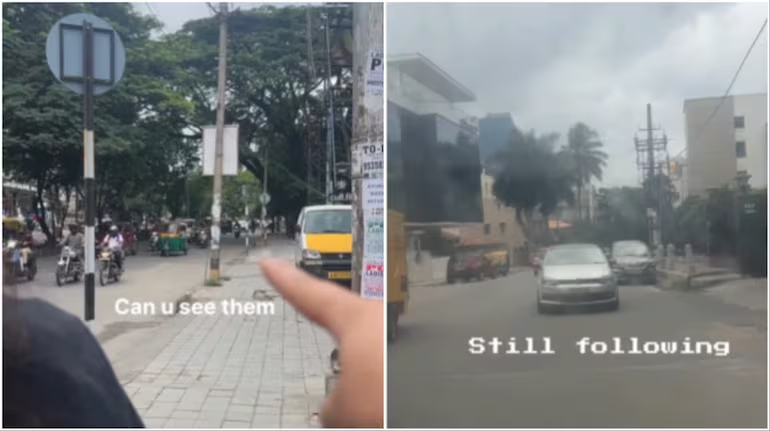Introduction
In yet another shocking incident that has stirred fear and fury across India, two young women in Bengaluru recently shared a disturbing video on social media showing three unidentified men trailing and harassing them late at night. The video quickly went viral, sparking a nationwide conversation about women’s safety, the increasing menace of street harassment, and the urgent need for systemic reforms to ensure public security.https://www.moneycontrol.com/
The incident, which reportedly occurred in a relatively busy part of Bengaluru, has not only horrified viewers but also triggered political responses, online activism, and renewed calls for better patrolling, surveillance, and accountability. The trauma experienced by the women in the video sheds light on the everyday fear many Indian women face while navigating public spaces.
This article provides a comprehensive account of the incident, its aftermath, the police response, and the broader societal implications.
The Incident: A Night Turned Nightmare
According to the victims, the two women were returning home after a casual evening out when they noticed three men suspiciously following them on a deserted stretch of road. Sensing something was off, one of the women began recording the incident discreetly with her mobile phone. In the chilling video, the three men can be seen gradually closing in on the women, whispering and leering, while occasionally quickening their pace.
The tension in the video is palpable. The women can be heard discussing whether they should run or confront the men. Their voices, though composed, betray an undercurrent of panic. Fortunately, they managed to reach a safer, more populated area and called for help before any physical harm occurred. Later, they posted the footage online with a caption that read: “We were scared and traumatised. This should not happen to anyone.”
Social Media Erupts: Outrage and Solidarity
The video gained rapid traction on platforms like X (formerly Twitter), Instagram, and Facebook. It was shared thousands of times within hours, with the hashtag #BengaluruSafety trending by the next morning.
Many users expressed shock and sympathy for the victims, with netizens and influencers alike decrying the lack of safety in urban India, even in metropolitan cities like Bengaluru. The story also prompted many women to share similar personal experiences, creating a wave of collective testimony around everyday harassment and the fear of walking alone at night.
Some notable posts included:
- @TheDesiFeminist: “This is what women in India go through all the time. The fear, the anxiety, the trauma. We need accountability. NOW.”
- @ITGuyBengaluru: “If our tech capital isn’t safe for women, what does that say about the rest of the country?”
Police Response: FIR Registered, Hunt On
Once the video surfaced, Bengaluru Police responded on social media, acknowledging the incident and assuring swift action. Within 24 hours, an FIR was registered under IPC Sections related to stalking, criminal intimidation, and harassment.
Police Commissioner B. Dayananda confirmed that CCTV footage from surrounding areas was being scanned to identify the suspects. A statement released by the city police read:
“We take this incident very seriously. An FIR has been registered and our teams are working round the clock to track the accused. Citizens’ safety is our top priority.”
Additionally, the women were offered psychological support and counseling services by the police department’s women’s help unit.
Political Reactions: “Wake-Up Call for Law Enforcement”
As the video gained national attention, politicians across the spectrum weighed in on the issue. Karnataka Home Minister G. Parameshwara condemned the incident, saying:
“This is unacceptable in a city like Bengaluru. We will strengthen patrol units, particularly at night, and ensure such offenders are brought to justice.”
BJP leader Tejasvi Surya, MP from Bengaluru South, tweeted:
“This incident shows the need for stronger surveillance and community policing. Our women deserve better.”
Meanwhile, women’s rights groups criticized what they described as a “reactionary” approach by the government and called for structural changes, including increased lighting in poorly lit areas, better public transport safety, and gender-sensitization programs for men.
Public Safety in Bengaluru: A Growing Concern
Bengaluru, often dubbed the “Silicon Valley of India,” has seen a surge in reported crimes against women over the past few years. According to NCRB data, cases related to molestation, stalking, and verbal harassment have risen steadily, raising alarm bells for city officials.
Many residents, especially women, complain about inadequate police presence in interior neighborhoods and insufficient night patrolling, even in relatively upscale or commercial areas. While initiatives like Pink Hoysala (a women-focused patrol unit) have helped, their reach is still limited.
In light of this recent incident, citizens have begun petitioning for:
- Increased police patrols between 9 PM and 3 AM in residential and commercial areas.
- Installation of more street cameras with real-time monitoring.
- Public safety apps with panic buttons directly linked to local police stations.
- Awareness campaigns targeting men and young boys about consent and respectful behavior.
Women Speak Out: “We Live in Constant Fear”
The traumatic incident in Bengaluru has resonated with thousands of women who see themselves in similar vulnerable situations every day. For many, it has revived memories of walking home with pepper spray clutched tightly, pretending to be on phone calls, or changing routes just to avoid an alley.
A 26-year-old IT professional, Priya S., shared:
“What happened to those girls could’ve happened to me. I take cabs late after my shifts and always feel like I’m being watched. It’s exhausting.”
Another woman, a college student, remarked:
“Even in 2025, we are talking about street safety like it’s a luxury. It’s depressing.”
These testimonies highlight the normalization of fear that women have internalized in their daily lives — a fear that men, by and large, do not face in the same way.
Legal Framework and Loopholes
India’s legal system has evolved over the years with specific laws to address crimes against women, including:
- Section 354D IPC (Stalking)
- Section 509 IPC (Outraging modesty of a woman)
- Section 354 IPC (Assault or use of criminal force with intent to outrage modesty)
While these laws are in place, the problem often lies in the implementation and conviction rate. Many women don’t report harassment due to fear of being blamed, police apathy, or social stigma. Others say that even if cases are filed, they drag on endlessly in courts.
Urban Design and the Role of Infrastructure
Experts also point to urban design as a major contributor to unsafe environments. Poorly lit streets, lack of CCTV surveillance, and deserted bus stops create conditions that embolden harassers.
Urban planner Shilpa Rao notes:
“Cities are built by men, for men. We need inclusive designs — better lighting, public toilets, footpaths, and 24/7 transit connectivity for women to feel safe.”
Simple changes like trimming bushes, adding lights, and ensuring functioning street cameras can dramatically reduce crime in high-risk areas.
Tech as a Solution: Apps and Digital Safety Nets
In response to growing safety concerns, several safety apps and platforms have been launched in India. Apps like Raksha, Smart24x7, Safetipin, and the government-backed 112 India provide panic buttons, location sharing, and direct contact with emergency responders.
However, digital rights activists caution that apps are only part of the solution. Unless backed by real-time law enforcement readiness, these tools become symbolic rather than effective.
Moving Forward: What Needs to Be Done?
The Bengaluru incident serves as a chilling reminder of the urgency to act decisively on women’s safety. Key steps include:
- Rapid Investigation and Punishment
Quick identification and arrest of the perpetrators will serve as a deterrent. - Police Reforms and Training
Gender-sensitization training, better night patrolling, and improved response time are essential. - Public Infrastructure Overhaul
Improve lighting, increase camera coverage, and design safer public spaces. - Public Awareness Campaigns
Educate the public — especially men — about the impact of harassment and the importance of respecting boundaries. - Safe Transport Policies
Mandatory background checks and GPS monitoring for taxis, autos, and buses. - Mental Health Support for Victims
Counseling, legal aid, and community support must be available for survivors of harassment.















Leave a comment